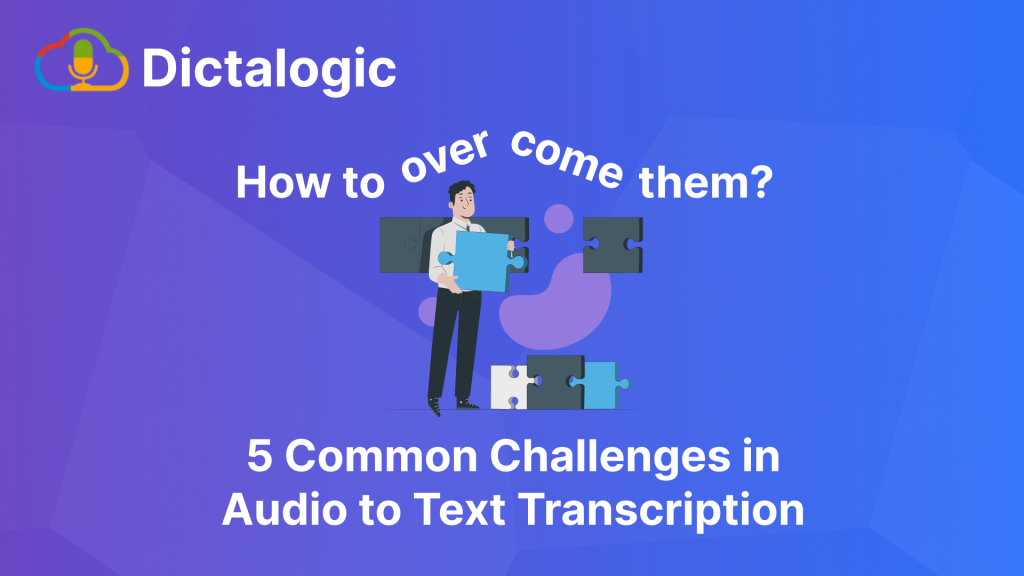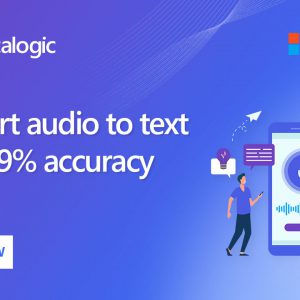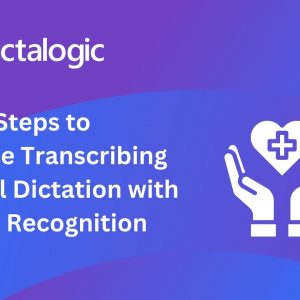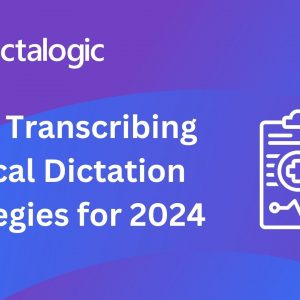Audio to text transcription is greatly valued in the fast-moving world of digital communication. Audio is transcribed into text, where voices are transcribed to become texts that enable access and documentation, as well as content creation. Its usefulness cuts across business professionals, content creators, and lawyers.
While smooth workflow and clear communication are great factors in transcription, accuracy is quite a hard catch. Crummy audio quality and very complicated jargon are two nightmares for a transcriptionist.

This blog tackles five common problems encountered with audio to text transcription and offers workable steps that can be applied to each situation, empowering you with the knowledge to overcome these challenges.
5 Challenges in Audio to Text Transcription and You Will Overcome Them
1. Poor Audio Quality: The Big Hurdle
The Problem:
Audio quality is the cornerstone of any transcription operation. Low-quality recordings, background noise, volumes too low, echo, or distortion can significantly complicate the process. These issues could stem from faulty recording equipment, unsuitable recording environments, or interference from external noises, turning ordinary conversations into gibberish.
It was, say, a corporate meeting at a busy café, and it was almost impossible to distinguish between speakers; with the clinking of dishes and people chattering in the background, the background music added to the cacophony.
How to Overcome:
Preventive Measures:
- Quality Recording Equipment: Quality-grade microphones and high-grade recorders to record sound.
- Optimal Environment: Record in a soundproof or quiet space. For remote recording, equip yourself with noise-cancelling instruments.
Audio Enhancements after Recording:
Use audio editing software like Audacity, Adobe Audition, and Logic Pro to clean the background noise, normalize audio levels, and eliminate echoes or statics.
Professional Transcription Tools
AI-based software such as Otter.ai or Sonix should be the go-to choice. These tools integrate advanced algorithms that can handle complex audio issues, ensuring the transcriber can produce clean audio.
Backup Recording Using Multi-Devices
Record in multi-devices. At this stage, audio loss can not be avoided. This cuts the work on transcription and gives greater accuracy with the audio quality set at the very early stage.
2. Accent and Dialects-A Puzzle in Language
The Problem:
Language is not homogenous, and accents and dialects in pronunciation make it quite tough to transcribe. At times, regional pronunciation, idiomatic expressions, and cultural nuances even make the experienced transcriptionist or AI tool mistake or give a wrong meaning.
All countries listening to the same medical conference would hear the exact term “vitamin,” but it would be pronounced differently in American and British English.
Reduction:
Extremely Advanced Training in AI Tools:
Train transcriber software based on multivariant data. Transcription software and tools like Temi and Trint work seamlessly since AI adaptability is a task.
Native Experts:
Ensure that the project transcriber will capture all the dialects, hence particular accents, used.
Pre-session Prep:
- If possible, teach the speakers how to speak clearly and avoid using heavy slang or extremely localized terms.
- Ask the speakers to list regional phrases or unique terms beforehand.
Proofreading and Editing
Post-transcription review also catches accent-related misinterpretation errors. Accent and dialect handling is a special concern in industries such as legal transcription, where an incorrectly transcribed word significantly changes the meaning.
3. Overlapping Speech: The Chaos Factor
Problem:
When transcribing a group discussion or interview, overlapping speech occurs among the speakers. It becomes difficult for a person to decide whether someone said something or a crucial piece of information was missed.
Real-life Example:
In virtual brainstorming, people get so excited simultaneously that jumbled audio is produced with both speaking.
How to Address it.
Encourage Formatted Communication:
Ground a meeting or interview, meaning one sets the rules to mini-grounding ewer interruptions and means setting the rules to minimize interruptions; ai is speaker diarylation, whereby the overlapping conversation between the speakers is separated and named.
Human Input in Clarity
- After scanning the dynamics, I replay to identify speakers who know them well.
- Multi-recording and angles
- Audio can be recorded onsite by setting many gadgets around the room. This will ensure a better recording of the people’s voices.
- Even during peak overlaps, the approaches involved may correct the transcript and make it noiseless.
4. Technical jargon and Industry specific terms.
Problem:
Such vocabulary needs are technical, with abbreviations not found in everyday transcriptionist dictionaries. Misspelling or typing the words mistakenly, and there are possible huge mistakes.
Such are words from an already legal deposition such as “res judicata” and “amicus curiae,” or what an unprofessional transcriber believes to be wordy nonsense.
How to Move Past It:
Customary Glossaries:
Many transcription tools allow you to upload custom dictionaries containing special industry terms. Medical doctors can create lists of standard terms like “angioplasty” or “metastasis.”
Specialized Transcriptionists:
You can hire transcriptionists who are knowledgeable in your field. Only such experts with contextual knowledge can technically interpret jargon.
Continual AI Training:
You can buy software that learns and develops its expertise in your industry over time.
Supplemental Documents:
You can submit the transcriptions files to your individual or software, with agendas, key presentations, or keywords on meetings that will enable transcriptions’ accuracy. In this regard, industries would be very grateful to couple this technology with human power that often uses transcription for critical files.
5. Ineffective Processes: Speed over Quality
The Problem:
Transcription is very time-consuming, especially when the recording is long, or the file is large and requires highly accurate transcription. Even the best computerized equipment needs significant proofreading to remove errors.
Real World Example
A podcaster could spend hours transcribing for each session, meaning that their content could take longer before release.
How to Solve:
Automation of the First Draft:
AI Transcription software like Sonix or Trint can speed up the drafting process and save hundreds of hours of manual effort.
Hybrid Approach
Transcribe automatically and let human beings check it. An automated draft can be used for editing and accuracy checks.
Outsource
Partner with transcription services that can handle bulk projects. Companies like Dictalogic are well prepared to do high-volume transcription efficiently, especially under time pressure. Break up long audio files into smaller chunks to make transcriptions easier and faster.
Simplified Process Flow:
Take advantage of built-in tools that can integrate transcription with other software, like CRM or content management systems, to cut down the number of steps involved in processing
The best speed and tools must be balanced with the best skill and optimal workflow needed for that project. This balanced approach ensures accurate and efficient results.
Other Emerging Trends to Overcome Traditional Transcription Challenges
With rapid innovation in transcription technology, there are always breakthrough solutions that will address these very traditional challenges. Some trending issues include:
- AI Powered Live Transcription
- Live Transcription Tools
- Live meeting and event transcriptions such as Otter.ai.
- Advanced tools now work through multiple languages and automatically jump between them to service clients worldwide.
Video Conferencing Support:
Zoom and Microsoft Team have integrated transcriber in their apps, thus eliminating laborious, time-consuming manual processes.
Context Aware AI
The conversational AI models are getting smarter these days. Hence, the cases of homophone homographs or ambiguous terms-related errors are lessening.
Voice Based Speaker Identification
AI is advancing in identifying speakers by voice and behavior, making it making discussions or interviews.
Final Thoughts: Mastering Audio to Text Transcription
Transcription of speech by audio can be quite demanding sometimes, but it is manageable if the strategies and the tools are in the right direction. Sometimes, this activity could include poor audio quality, complicated accents, and even overlapped speech, among so many other challenges that the efficiency is sure once those barriers are broken.
Investing in modern transcription technology and expert professionals and putting best practices into the transcription process allows people and businesses to save time and money and use their energy on other things toward different goals. And if you want to know the top benefits of using an Audio-to-Text Converter then read our blog.
Dictalogic specializes in providing businesses and individuals with high-accuracy, efficient, and scalable transcription services that enable them to overcome transcription challenges smoothly. Contact us today to learn more!




